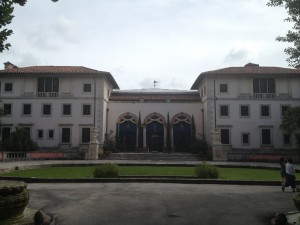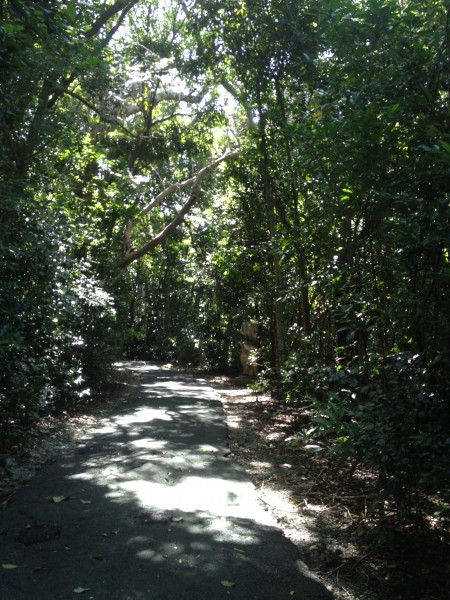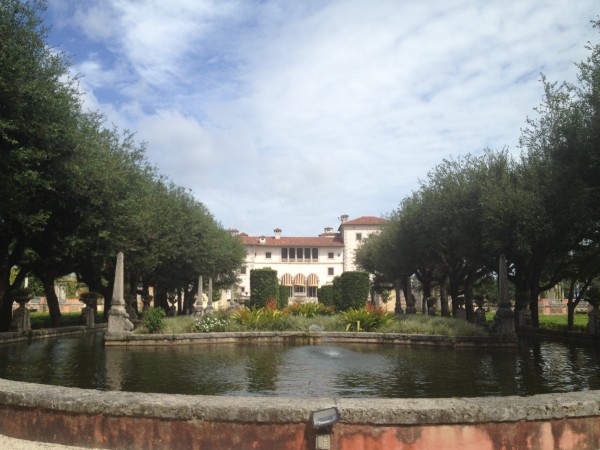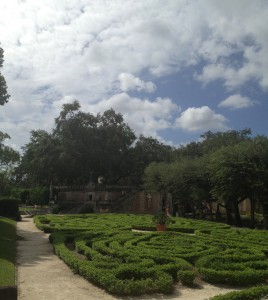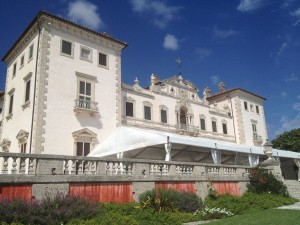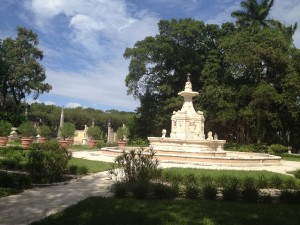Posted November 6, 2012
By EMMA REYES
MIAMI, Fla.—It was a sunny and breezy Wednesday afternoon in late October. My excitement caused by visiting Vizcaya Museum and Gardens was high because touring historical places for me is hard due to the accessibility it may or may not have for my wheelchair.
My trip started by riding the Metrorail to make my way to the Vizcaya Station where I would get off to go to the estate. It was a short and smooth ride and the path to the estate was easy due to the signs that direct every visitor.
Vizcaya is an estate in the middle of the big city with history about the Jazz Age in Miami. It’s a place James Deering built where visitors can learn about art, interior design, architecture, landscape design, horticulture and the environment of Miami.
As I made my way to the entrance of the estate I saw a sign that read, “Nature Path to Vizcaya Entrance.” To make my experience more memorable, I decided to take this path. It was a rocky path for my wheelchair and a little uncomfortable, but the path made it seem as if I was in the middle of a tropical hardwood hammock and not in the major city of Miami.
I could hear birds chirping and the tall green trees hovering the path were a perfect setting for my journey to the entrance. As I made my way to the end of the path I saw a statue where I knew the beginning of my tour of the estate would start.
I got to a gate where I would get my ticket to enter the estate. There was a young man who greeted me and helped with my admission. He asked if I wanted to take the audio tour and agreed, thinking it would offer a full experience and more information about Vizcaya.
As I started the tour, I took a minute to admire the beauty of the house. The estate has numerous windows and one balcony on every side. The focus of the house is the entrance with high columns and two windows with the door to enter the historical place.
Because the house is about 100 years old and there are steps in the main entrance, I had to go through a side entryway where a lift has been placed for wheelchair access.
It was a smooth and quick ride up. As I made my way inside, but no interior photos are allowed to preserve the inside of the house, I took my time to look and admire every detail. The audio tour was a great help to take the full experience of the house because of all the information given and it was easy to use since it looks like an iPod.
I pushed the number of the area I wanted to learn about and it was as easy as that, the numbers for the areas are in the map that is given when the audio tour is requested.
Vizcaya was the home of American industrialist James Deering where he lived only in the winter months from Christmas 1916 until his death in 1925. He lived in this house with a large staff that managed the estate.
Deering chose this area because of the climate in the wintertime and because of the appreciation he had for the native hardwood hammock. His father, William, lived in the area of Coconut Grove and his half brother was planning on developing an estate in Cutler.
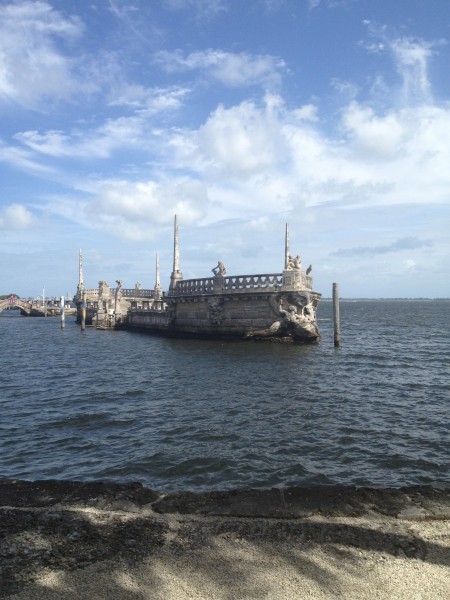
View of the gondolas where Deering and his guest would arrive by yacht for parties (Photo by Emma Reyes).
During this period in Miami, the population was around 10,000 and more than 1,000 workers were employed in the Vizcaya development. The employees were laborers and craftsmen from the Caribbean and Europe.
Besides the house and gardens, the estate included a farm, livestock and a range of other service facilities covering 180 acres, which covers both sides of South Miami Avenue.
To create this Mediterranean style villa, Deering worked with Paul Chalfin, a young New York painter who supervised the entire project and architect F. Burrall Hoffman and Colombian landscape architect Diego Suarez.
Deering and Chalfin traveled throughout Europe to gain inspiration for the estate by looking at residential architecture such as doors, wall panels, mantels and ceilings. The Italian Renaissance style estate was to appear as if it had stood for 400 years. It has 34 decorated rooms with 15th through 19th century vintage furnishings and art pieces.
The gardens have elements of Italian Renaissance and French designs, which Suarez and Chalfin worked for seven years. The design of the gardens was to perfect the enormous outdoor room with the elements that serve as complementary parts of an integrated area.
Key features of the gardens include several fountains, a central pool surrounding an elevated island, the elevated Mound with its small house, the “Casino” as it is known, statuary, and numerous themed gardens.
After touring the first floor of the house, I made my way outside. I was not able to tour the second floor where Deering’s bedroom, breakfast room and kitchen are located. A video of the second floor was provided on the first floor and although the video offered interesting information of the rooms upstairs the experience was not the same as actually going through every room.
As I made my way to the gondolas, the view of the bay was stunning on this location.
It was absolutely breathtaking with a blue sky, big white puffy clouds and a radiant sun, which transported me to Christmas Day 1916 when Deering and his guests arrived by yacht for a masquerade party – a detail I learned by listening to the audio tour.
There were two parts of the gondolas where my wheelchair couldn’t go to, but the areas where I did get to go to were very accessible.
I then made my way to the gardens. In this area of the estate the same situation occurred when I started my tour. The pathways and the accessibility were challenging for me.
As a person sitting in a wheelchair to get from point A to point B, the pathways are very important and in the Vizcaya estate the pathways are very rocky and this made my experience a little uncomfortable.
It was difficult to get the full experience because I was constantly looking down and making sure my wheelchair didn’t get stuck anywhere.
There were also some areas where my wheelchair was not able to get to, such as the “Secret Garden,” “On the Mound” and the “Casino.” This was because of the steps, so I enjoyed them from afar.
Aside from the rocky paths and inaccessible areas, the gardens were a beautiful sight – the green color of these gardens all around give it a gorgeous break from a big city like Miami with all the tall buildings in Downtown.
The gardens have a peaceful way about them. It’s a perfect place to take a moment and be with nature and get lost in thought. The sounds of the fountains give the area another peaceful element and made me appreciate the estate more, especially being in the middle of the city.
IF YOU GO
-
Vizcaya is located at 3251 S. Miami Ave. north of the Coconut Grove area in the City of Miami. It overlooks a wide area of Biscayne Bay.
- Admission to the estate is $15 for adults, $6 for children from 6-12 and children 5 and under enter for free. Adults 62 and older with ID enter for $10 and so do students with ID.
- Visitors can get to the Vizcaya estate by riding the Metrorail and getting off at the Vizcaya Station, then crossing U.S. 1 on the pedestrian bridge and continuing in the same direction, which is one block to South Miami Avenue. After that, cross SW 32nd Road and continue onto the crosswalk that crosses South Miami Avenue to enter Vizcaya.
- Parking at Vizcaya is free parking for cars and arrangements for buses and large vehicles for group tours can and should be made in advance by e-mailing the visitor service coordinator at group.tours@vizcayamuseum.org or calling 305-860-8421.
-
Vizcaya has a café and shop that is open from 10 a.m. to 5 p.m. It offers sandwiches, salads, desserts and other refreshments and there is an area where guests can eat overlooking the swimming pool of the estate. Vizcaya also offers prepared food and accommodates small groups for breakfast or lunch during regular museum hours. For more information, e-mail Paula Gooden at paulag@ajoywallace.com
- Guests can also join the café and shop for “Tea for Two on Sundays” from 1 to 4 p.m. for $16.

